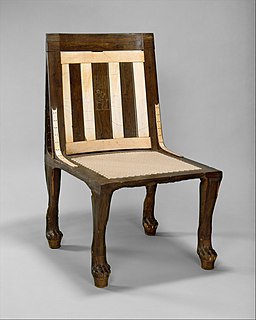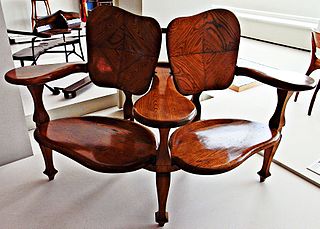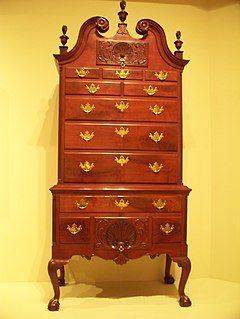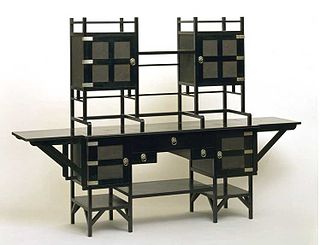 W
WThe 10 Downing Street Guard Chairs are two antique chairs. In the early 19th century, 10 Downing Street was guarded by two men who sat outside the building in leather chairs made by Thomas Chippendale. There was a drawer underneath the chair which was filled with hot coals to keep the guards warm whilst on duty. The chairs were hood chairs, made with a circular back and hood, both to shield the guards from bad weather and to improve the surrounding acoustics, thereby allowing the guard to hear better from a wider angle.
 W
WA bill hopper is a piece of furniture used for the receiving of bills in the United States House of Representatives. It was formerly used in the United States Senate.
 W
WThe Chair of Reniseneb is an Egyptian wooden chair dated to the 15th century BC. The chair, currently on display at the Metropolitan Museum of Art, belonged to the Egyptian scribe Reniseneb.
 W
WThis carved lacquerware table in the Victoria and Albert Museum in London is from the Ming dynasty (1368–1644). It is unique in shape and decoration and is one of the most important objects from the period. It is one of the few surviving examples in the world of a major piece of furniture produced in the 'Orchard Workshop', the Imperial lacquer workshop set up in the early Ming period and situated to the north-west of the 'Forbidden City' compound in Peking.
 W
WThe Confidant from Casa Batlló, also known as the Double Sofa or Banc de dues places , is a furniture piece designed by Antoni Gaudí. Originally designed for the dining room of Casa Batlló on Barcelona's Passeig de Gràcia, the chair is currently exhibited in the Modern Art collection of the Museu Nacional d'Art de Catalunya and at Casa Museu Gaudí in Barcelona. Replicas are displayed at the Gaudí-designed Casa Batlló and Casa Milà.
 W
WThe Great Bed of Ware is an extremely large oak four poster bed, carved with marquetry, that was originally housed in the White Hart Inn in Ware, England. Built by Hertfordshire carpenter Jonas Fosbrooke about 1590, the bed measures 3.38m long and 3.26m wide and can 'reputedly... accommodate at least four couples'. Many of those who have used the bed have carved their names into its posts.
 W
WThis high chest of drawers, also known as a highboy or tallboy, is part of the Decorative Arts collection of the Indianapolis Museum of Art in Indianapolis, Indiana. Made between 1760 and 1780 in Philadelphia, Pennsylvania, its design was inspired by British furniture-maker Thomas Chippendale.
 W
WJohn Evelyn's cabinet is a highly decorated storage box in the collection of the Victoria & Albert Museum in London. The cabinet was probably made in Florence for the diarist John Evelyn (1620-1706), and is an early example of a piece of furniture commissioned by a British visitor making the 'Grand Tour' of Europe.
 W
WMadame Guimard's furniture is a set of Art Nouveau bedroom furniture, designed from 1909 onwards by the Lyon-born architect Hector Guimard for his new wife, the American artist Adeline Oppenheim. They married in 1909, and the same year he bought a site at 122 Avenue Mozart in the 16th arrondissement of Paris to build a three-storey hôtel particulier, or mansion. When the site was sold in 1948, Madame Guimard gave the bedroom furniture to the Musée des Beaux-Arts de Lyon, the desk to the musée de l'École de Nancy and the dining room furniture to the Petit Palais.
 W
WThe marriage bed of Henry VII was a bed designed and built for use on the night of his marriage to Elizabeth of York on 18 January 1486. The marriage symbolised the end of the War of the Roses by joining Henry's House of Lancaster to Elizabeth's House of York and the bed's design reflected this featuring both the White Rose of York and the Red Rose of Lancaster. A carving on the headboard depicted the Royal couple as either Adam and Eve or Christ and the Virgin Mary defeating the animals that opposed Christ in Psalm 91 and bringing paradise to England. The bed also includes the arms of France, reflecting Henry's possessions and ambitions there, as well as religious and fertility symbols.
 W
WThe Model 60 stacking stool is a wooden stool designed by Finnish designer Alvar Aalto in 1933. Manufactured by Artek, the stool is one of Aalto's most famous furniture designs.
 W
WModern Gothic exhibition cabinet is a piece of Modern Gothic furniture now in the collection of the Metropolitan Museum of Art. Although its design was once attributed to Philadelphia architect Frank Furness and furniture maker Daniel Pabst, MMA now credits its design and manufacture to Pabst alone. At 8 feet (2.4 m) tall, it is an unusually large and polychromatic American example of the rare style.
 W
WMy Bed is a work by the English artist Tracey Emin. First created in 1998, it was exhibited at the Tate Gallery in 1999 as one of the shortlisted works for the Turner Prize. It consisted of her bed with bedroom objects in a dishevelled state, and gained much media attention. Although it did not win the prize, its notoriety has persisted. It was sold at auction by Christie’s in July 2014 for £2,546,500.
 W
WThe Red and Blue Chair is a chair designed in 1917 by Gerrit Rietveld. It represents one of the first explorations by the De Stijl art movement in three dimensions.
 W
WThe sedia gestatoria or gestatorial chair is a ceremonial throne on which popes were carried on shoulders until 1978, and later replaced outdoors in part with the popemobile. It consists of a richly adorned, silk-covered armchair, fastened on a suppedaneum, on each side of which are two gilded rings; through these rings pass the long rods with which twelve footmen (palafrenieri), in red uniforms, carry the throne on their shoulders. On prior occasions, as in the case of Pope Stephen III, popes were carried on the shoulders of men.
 W
WThis sideboard was designed by Edward William Godwin (1833–86), who was one of the most important exponents of Victorian Japonisme or Anglo-Japanese style, the appropriation of Japanese artistic styles.
 W
WThe Woolsack is the seat of the Lord Speaker in the House of Lords, the Upper House of the Parliament of the United Kingdom. Before 2006, it was the seat of the Lord Chancellor.